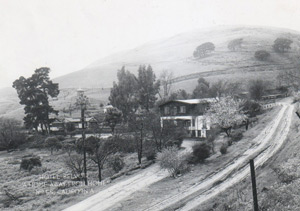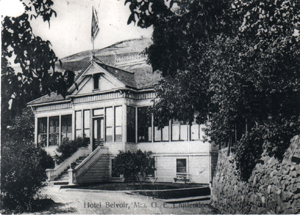 Palo Alto Stanford Heritage
Palo Alto Stanford Heritage 
Niles retains its small town charm despite being surrounded by a frenetic pace of development. It also harbors a unique gem called The Belvoir Springs. This 129–year-old Craftsman style building is nestled high above the town in the Niles Canyon hills.
The Belvoir originally consisted of 150 acres with a year-round spring and was purchased by Giles and Emily (Nana) Chittenden for $3,556. In 1884 they built a single story, 3 bedroom Stick–Eastlake style farmhouse, barn and outbuildings. Once part of Rancho Arroyo de la Alameda, the Chittenden’s acreage became a profitable fruit and nut orchard, dairy and vegetable farm. By the turn of the century, due to the charm of Nana and the beauty of the surroundings, it also became a summer camp for friends and travelers.
Life at The Belvoir was recounted by Marie Bishop, the Chittenden’s granddaughter:
"We all had to help Sookie, the Chinese cook, peel vegetables, etc. The cook was in the kitchen at 5 a.m. We frequently had to get people off the 7 a.m. train. Tables had to be set, people waited on, beds made and rooms cleared.... Fruit had to be picked and canned, nuts picked up and shelled. Visitors… helped making soap, canning, baking, and salads in summer. “
The Belvoir Springs’ growth kept pace with the town of Niles, founded in 1850 and named after Judge Addison C. Niles, a California Supreme Court Justice. Along with eight surrounding towns, it became part of Washington Township in 1853. The area attracted famous pioneers such as Jedidiah Smith, Kit Carson and John C. Fremont not only because of its fertile land and abundant water but also because of its strategic location connecting Los Angeles to the Bay Area, San Francisco and to the Mission Pass access to the gold fields. Niles first gained fame in 1869 when it became the final link in the Trans–Continental Railroad.
By 1902, Niles was a busy train stop with 24 passenger trains a day. That same year, rooms were added in The Belvoir’s basement to accommodate entrants in the popular San Francisco Bay bicycle races. During winter months, school teachers and Southern Pacific employees boarded at The Belvoir.
1912 proved a synchronous year for The Belvoir Springs and for Niles. A fire engulfed The Belvoir leaving only the basement, the rear utility wing and parts of the ground floor walls, windows and doors. The Chittendens rebuilt, producing a 22 room, wood–framed Craftsman building with gabled roofs. The overhanging eaves had fascia boards, notched rafters and exposed beams. Horizontal wood cladding on the first story complemented wood shingles on the upper, with a veneer of vertical notched boards in the gables. The wood–sash windows had narrow surrounds with peaked tops.

The simplicity of The Belvoir’s exterior belied the breath-taking interior. The main hall offered maple floors, a coffered boxed–beam ceiling, board and batten wainscoting with plate railing and a brick fireplace flanked by a leaded glass cabinet. This fir wainscot and ceiling treatment was repeated in the 15’ x 30’ dining room which adjoined two sitting rooms and had a large built–in china cabinet with leaded glass doors. A winding staircase with boxed newel posts and wainscot was illuminated by a massive skylight and led to the well-appointed bedrooms.
Meanwhile, Niles became home to one of the first West Coast movie companies, Essanay Studios. Founded in Chicago by George K. Spoor and Gilbert M. Anderson, hence the name “”S” and “A”, Essanay opened its Niles branch in 1913. Gilbert Anderson, known as “Bronco Billy”, had starred in the increasingly popular genre of westerns. He found the golden, oak studded hills and winding dirt roads of Niles to be the perfect backdrop for his movies. By 1915, Essanay had also signed up Charlie Chaplin who made five films in Niles including his masterpiece, The Tramp.
Essanay Studios brought prosperity to Niles and to the Chittendens. The register of The Belvoir Springs from 1913 to 1918 reads like a Who’s Who of silent films. The entire production company, including “Bronco Billy” Anderson, Augustus Carney, Josephine Rector, James Robbing, Bessie Stankey, Wallace Beery, Marie Dressler, James Gleason, and Charlie Chaplin with his paramour, Edna Purviance, came to The Belvoir to live, dine and unwind after filming two to five 15–minute movies per day.
The Essanay Studios in Niles closed in 1916 when the company consolidated its operations at their Los Angeles studio. Nana Chittenden retired a year later. The Belvoir passed through a succession of landlords and owners who sold acreage and allowed this historic property to fall into disrepair. By 1994, Susie and Jim Richardson bought the property, now 21 acres, and undertook a major rehabilitation of the house, gardens and spring–fed water system. Returned to its former splendor, The Belvoir’s guest book once again lists prominent names and functions as a venue for special events and extended stay rentals. ©
PAST, August 2, 2013
| |
E-mail us at either webmaster@pastheritage.org or president@pastheritage.org.
![]() Palo Alto Stanford Heritage—Dedicated to the preservation of Palo Alto's historic buildings.
Palo Alto Stanford Heritage—Dedicated to the preservation of Palo Alto's historic buildings.
Copyright © 2015 Palo Alto Stanford Heritage. All rights reserved.